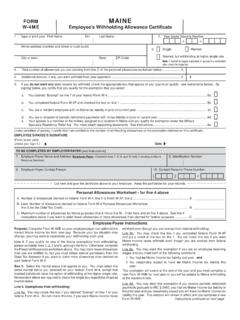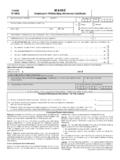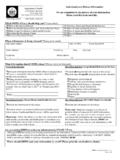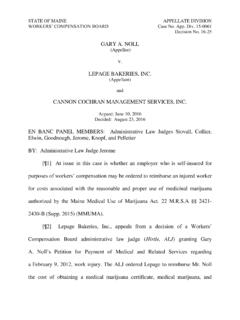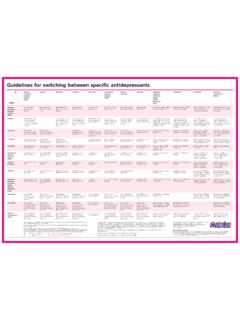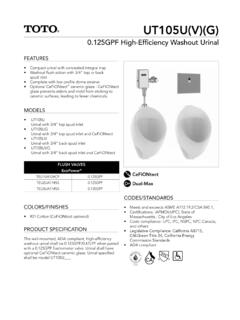Transcription of Troubleshooting Activated Sludge Processes Introduction
1 Troubleshooting Activated Sludge Processes Introduction Excess Foam High Effluent Suspended Solids High Effluent Soluble BOD or Ammonia Low effluent pH Introduction Review of the literature shows that the Activated Sludge process has experienced operational problems since its inception. Although they did not experience settling problems with their Activated Sludge , Ardern and Lockett (Ardern and Lockett, 1914a) did note increased turbidity and reduced nitrification with reduced temperatures. By the early 1920s continuous-flow systems were having to deal with the scourge of Activated Sludge , bulking (Ardem and Lockett, 1914b, Martin 1927) and effluent suspended solids problems. Martin (1927) also describes effluent quality problems due to toxic and/or high-organic-strength industrial wastes. Oxygen demanding materials would bleedthrough the process. More recently, Jenkins, Richard and Daigger (1993) discussed severe foaming problems in Activated Sludge systems.
2 Experience shows that controlling the Activated Sludge process is still difficult for many plants in the United States. However, improved process control can be obtained by systematically looking at the problems and their potential causes. Once the cause is defined, control actions can be initiated to eliminate the problem. Problems associated with the Activated Sludge process can usually be related to four conditions (Schuyler, 1995). Any of these can occur by themselves or with any of the other conditions. The first is foam. So much foam can accumulate that it becomes a safety problem by spilling out onto walkways. It becomes a regulatory problem as it spills from clarifier surfaces into the effluent. The second, high effluent suspended solids, can be caused by many things. It is the most common problem found in Activated Sludge systems. Sometimes a suspended solids problem carries with it a particulate-matter BOD problem if the effluent TSS gets quite high.
3 Ordinarily, one mg/L of effluent TSS produces about mglL BOD5 At low values of BOD5 plus TSS, the sum of the soluble BOD5 and BOD from TSS values often equals the TSS value. The third is high concentrations of soluble materials traveling through the system and not being properly treated. BOD bleed-through is rare in domestic treatment systems where problems are usually related to particulate BOD contained in suspended solids. However, excess ammonia can often appear in domestic effluents. BOD bleed-through is much more common in industrial systems or combined domestic/industrial systems where slowlymetabolized compounds cannot be stabilized in a short detention-time Activated Sludge system. The fourth general problem relates to low effluent pH. It is found most often in geographical areas with naturally low-alkalinity water supplies where extended aeration and/or nitrification Processes are used.
4 It is usually fairly easy to control. However, the problem can also be caused by low influent pH and control may be more difficult. Schuyler (1995) has identified 32 different conditions for one of these four effluent problems to exist. These are shown in the following two-page Troubleshooting guide. There are probably many other situations, but these represent the vast majority of the significant problems. The following discussion addresses each of those 32 conditions and the process control changes that should be made to eliminate the problem. While using this chart, it must be remembered that elimination of one problem may allow another problem to show up. Further, one condition may overshadow another such that the second condition cannot be observed until the first is eliminated. Finally, it is difficult to precisely defme control actions relative to specific numbers, such as an MCRT of 5 days or a return rate of 25 percent of Q.
5 Therefore, most control actions are discussed relative to the direction iliat change is needed. For instance, for condition 23, the control action is to decrease wasting and return. The actual amount depends on actual conditions and cannot be specified here. A plastic laminated wall chart is available from Rothberg, Tamburini, & Winsor, Inc. Excess Foam Conditions 1 through 5 relate to excess foam in the system (Jenkins, et al., 1993). When considering foam problems the question must be asked, "Is the amount of foam that exists a problem?" If it is not a problem, the situation may be better left unresolved. Many people observe foam and consider it a problem when it is not. For instance, a dark leathery Nocardia foam may look bad on an aeration tank but may not be affecting effluent quality. However, the situation may arise where someone's boss or the public thinks it's a problem; then it becomes the operator's problem.
6 Condition 1- Pumice-Like Foam This type of foam often appears gray but if one looks closely, they observe that the foam has a large number of dark specks. This foam is usually due to solids returned from Sludge processing. It may be due to poor solids capture from a belt press or a centrifuge or from digester supernatant return that contains excess solids. The key to improvement of this condition is to improve the solids capture in the Sludge processing scheme. Condition 2 - Slimy Foam A grayish slimy foam that is very thick is commonly caused by nutrient deficiencies. It is often noted with a slime bulking condition. Those deficiencies may be either nitrogen or phosphorus. The solution usually involves addition of the limiting nutrient, such as ammonia to provide nitrogen, or phosphoric acid to provide phosphorus. There is usually enough nutrient if the ammonia plus nitrate in filtered ( m) effluent is greater than 1 mg/L and the soluble orthophosphate is greater than mg/L (Jenkins, et al.)
7 , 1993). However, in certain cases where easily degradable, soluble BOD is available, higher N and P concentrations may be necessary. Condition 3 - Dark Brown, Thick, Scummy Foam Old Sludge conditions usually cause a dark brown, thick, scummy foam. It is usually caused by the growth of Nocardia or Microthrix parvicella, both of which grow at the high MCRT/low F/M condition associated with old Sludge . A treatment pressure is required to decrease the total Sludge units in the system. Thus, one must increase wasting and try to remove foam from the system. Once Nocardia has started to grow profusely, it is difficult to eliminate through increased wasting. Therefore, removal of foam from the system becomes more important. Foaming due to M. parvicella appears to occur more during colder temperature conditions while Nocardia can bloom profusely under higher temperature conditions. Both also appear to like oils and grease in their diets.
8 Conditions 4 and 5 - White Billowy Foam White billowy foam is caused by high concentrations of surfactants such as detergents. It is not nearly the problem today that it was before biodegradable detergents were used. Condition 4 occurs at start-up of a system where a young Sludge exists due to low mixed liquor suspended solids concentrations. In this condition there are just not enough solids present to break the surface tension of the surfactant bubbles that form. Thus, billowy white foam can accumulate on the aeration tank and can even be blown around by the wind. The condition is usually short-lived since at start-up the operator is usually applying oxidative pressure by increasing the total Sludge units in the system. If the condition occurs due to previous excessive wasting, the solution is still to decrease wasting and increase the total Sludge units in the system. Condition 5 is found when there are higher concentrations of suspended solids.
9 The cause is usually a very high surfactant load such as may be found when certain industrial Processes are cleaned. Although there is a higher suspended solids concentration, it is still not high enough to break the surface tension of the surfactant bubbles. Again, an oxidative pressure is required to increase the total Sludge units by decreased wasting and it is also worthwhile to increase the solids detention time in the aerator by decreasing the return flow rate. High Effluent Suspended Solids High effluent suspended solids are usually caused by one of two conditions: either individual particles that will not settle are discharged or the Sludge blanket in the clarifier washes out. Either of these can cause conditions 6 through 24 to occur. Look first at clarifier blanket washout related to conditions 6 through 17. In this situation, the Sludge blanket in the clarifier actually rises close enough to the surface so that it washes over the effluent weir.
10 To learn the reason for the clarifier-blanket washout , the first thing to do is to look at the Sludge settleability. If the problem is not a blanket wash-out, it is individualparticle washout . The individual particles may be tiny pin-floc, large straggler-floc or individual, dispersed cells. Physical observation of the effluent and microscopic observation of the mixed liquor or effluent will show which type or combination of types of individual particles is involved. Hydraulic Overload ~ Conditions 6 and 7 If the settling test or diluted settling test shows that the Sludge settles well, then the blanket washout is usually due to too many solids in the clarifier. Condition 6 is caused by hydraulic overload of the clarifier. It results when too many solids are pushedinto the clarifier and they are not physically returned fast enough to the aeration tank. There are just too many solids applied to the clarifier.

